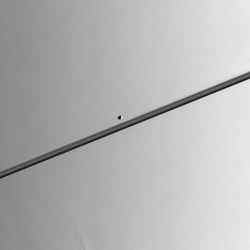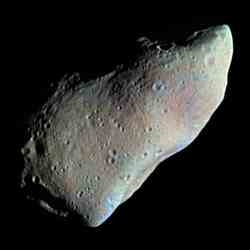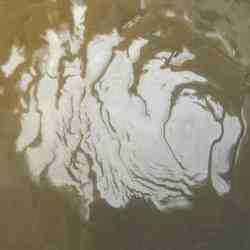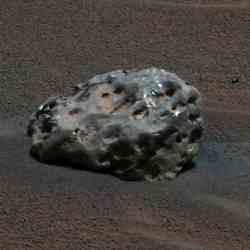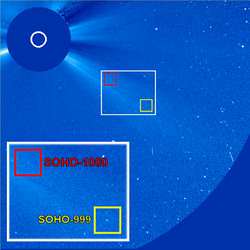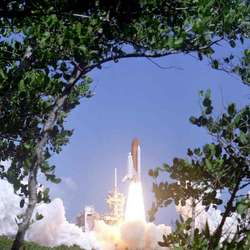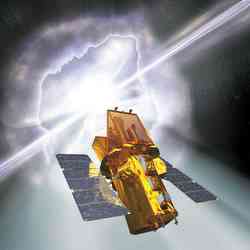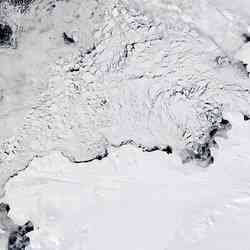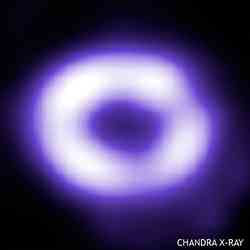
M8. Image credit: N.A. Sharp, REU Program, NOAO/AURA/NSF. Click to enlarge.
Monday, August 22 – Tonight let’s start by watching the dance of the ecliptic as Venus and Jupiter have now drawn within a fist’s width (10 degrees) of each other about 90 minutes after sunset. They’re about to get much closer!
With the later rise of tonight’s Moon, let’s take this opportunity to visit a deepsky object that’s great in either telescopes or binoculars. Are you ready to swim in the “Lagoon”?
Easily located about three finger width’s above the tip of the teapot’s spout – Al Nasal – the M8 is one of Sagittarius’ premier objects. This combination of emission/reflection and dark nebula could only get better as an open cluster is also involved. Spanning a half a degree of sky, this gem is loaded with features. One of the most prominent is a curving dark channel that divides the area nearly in half. On its leading (western) side you will note two bright stars. It is believed that the southern-most of this pair (9 Sagittarii) is the illuminating star of the nebula. One the trailing (eastern) side, is a loose collection of stars designated as NGC 6530 which contains 18 erratically changing variables known as “flare stars”. This is a very young group of stars, and still in the process of formation. For large scopes, and those with filters, look for many small patches of dark nebulae called “globules”. These are believed to be “protostar” regions – areas where new stars are undergoing formation. Return again to star 9 Sagittarii and look carefully at a very concentrated portion of the nebula to its west/southwest. This region is known as the “Hourglass” and it is a source of radio emission. How cool is that?!
Tuesday, August 23 – If you’re up before sunrise this morning, be sure to check out the eastern horizon. Can you spot Saturn with Mercury below it? Tiny Mercury has now reached its greatest elongation from the Sun (18 degrees) and is now as high in the pre-dawn sky as it will get.
Grab your binoculars tonight and head towards Sagittarius. About a thumb’s length northeast of the top star in the teapot’s “lid” – Kaus Borealis, you’ll discover a fine open cluster that’s equally impressive in a telescope. The M25 is a scattered galactic cluster that contains a cephid variable – U Sagittarii. This one is a quick change artist, going from magnitude 6.3 to 7.1 in less than seven days. Keep an eye on it over the next few weeks by comparing it to the other cluster members. Variable stars are fun!
Wednesday, August 24 – Around 3 hours after sunset tonight, we’re going to dispel a myth. At this time you will note a waning Moon, about 2/3 illuminated has already risen and that Mars is less than a fist’s width to its lower right. Just how big is it?
We’ve all heard the email scam that’s been around on the internet telling about this year’s Mars apparition. First let’s start with the myth. According to them, Mars will be 34,649,589 miles from Earth and appear as large as the full Moon in the sky! I’m sorry, but there’s something wrong with that equation. Let’s have a look at why…

This illustrates the size of our Earth, Moon and Mars. As you can see, Mars is about twice the size of our Moon. Now let’s use some logic. We know the the Moon is approximately one quarter of a million miles away, and we know how big it appears in our sky. For Mars to appear that large, it would need to be a million miles away! No matter how close we might come , it’s never going to be that close. Now let’s look at some facts…
During 2005 Mars will not be as close to Earth as it was in 2003. Fortunately, this year it will be higher in our sky, allowing everyone the opportunity to see and enjoy it. Mars is the only planet with a surface that can be plainly seen with details for even a small telescope and in 2005 and 2006 it will be at its best. Why? This time it will be above the celestial equator. This is good news for northern observers! Mars will be 32 degrees higher than it was in 2003, meaning we have far less of our own atmosphere to view through. This should provide considerably better observations of the Red Planet.
With a 4″ telescope and good conditions, you should be able to see large surface features, bright clouds, and the haze in the Martian atmosphere. Perhaps there will be a large dust storm, or you’ll witness the polar caps change. With a 6″ to 10″ telescope, the features will remain pretty much the same, but you’ll be able to follow them longer as Mars begins to shrink again. Larger scopes will pick out even more subtle features.
At first, your views may not be very exciting, but don’t stop watching. The Red Planet’s closest approach to Earth occurs at 04:21 UT on October 30th reaching its maximum diameter until November 6th. Of all the worlds we can observe, Mars is the most “Earth-like” with its changing seasons and polar caps. To the unaided eye, it will appear like a bright reddish star, but will lose its color to a faded orange in the eyepiece. Just like the Moon, it’s many features have been mapped and there are several on-line sites to help you get the most out of your Mars experience. Enjoy!
Thursday, August 25 – On this date in 1981, Voyager 2 made a fly- by of Saturn. Eight years later in 1989, Voyager 2 flew by Neptune on this date. Why don’t we make a “date” tonight to have a look at this distant blue world? After just having passed opposition on August 8, the gas giant is still holding a respectable magnitude 8 and can even be picked out with binoculars. You’ll find it northeast of Theta Capricornii.
Friday, August 26 – With plenty of time to spare before the Moon rises, let’s have a look at a great binocular target and a treasure trove for the telescope – M24. Located just above the top star in the teapot’s lid – Kaus Borealis – the M24 is often referred to as the “Small Sagittarius Star Cloud”. This vast region is easily seen unaided from a dark sky site and is a stellar profusion in binoculars. Telescopes will find an enclosed galactic cluster – NGC 6603 – on its northern border. For those of you who prefer a challenge, look for Barnard Dark Nebula, B92, just above the central portion.
Saturday, August 27 – With tonight’s dark sky, we’ll be undertaking a slightly more difficult study – M20.
Located about another finger width above previous study, M8, the “Trifid” nebula will appear in smaller telescopes as a double star with a faint nebulosity surrounding it. At low power, attendant open cluster M21 can often be squeezed into the same field of view. As aperture approaches the 8″ to 10″ range, so does resolution, and the “double” star will now reveal itself to be a triple (multiple) system – HN 40. The actual “Trifid” pattern that most of us recognize is in the southern portion of a much larger nebula – the region surrounding HN 40. These dark, dissecting dust lanes move off to meet space at the structure’s east and west edges, while the southernmost dustlane ends in brightest portion of the nebula. With much larger scopes, the M20 will show differences in concentration in each of the lobes along with embedded stars. It requires a dark night, but the “Trifid” is worth the hunt!
Sunday, August 28 – In 1789 on this day, Sir William Herschel discovered Saturn’s moon – Enceladus. So where is the “Ring King”? Then get thee up before dawn and look! Saturn has now risen almost a handspan above dawn’s early light. Can you still spot Mercury?
Next week means much darker skies and an opportunity to explore some of the summer’s finest deep sky objects. Until then? May all your journeys be at light speed! …~Tammy Plotner

